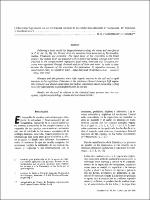Ciclos biogeoquímicos en un ecosistema forestal de los Andes Occidentales de Venezuela, 4: Modelos y conclusiones [suelos].
Alternative title
Biogeochemical cycles in a forest ecosystem of the Western Venezuelan Andes, 4: Models and conclusions [soils].
Abstract
Following a basic model for biogeochemical cycling, the stores and transfers of N, P, K, Na, Ca, Mg, Mn, Fe and Al in the montane forest ecosystem of San Eusebio, Merida, Venezuela, are presented. The input layer of the ecosystem is the forest canopy; the output layer was placed at 120 cm below soil surface Mineral stores were analysed in the compartiments vegetation, dead wood, litter and soil. Mansport processes were registered through chemical analysis of litter and water. In order to char-acterise the dynamics of the ecosystem the parameters 1) vegetation turnover, 2) input-output-ratio, 3 ) vegetation store — input-ratio and vegetation store — turnover — ratio, were used.
Nitrogen and phosphorous show high organic reserves in the soil and a rapid turnover in the vegetation. Potassium is the minimum element showing a high vegetation turnover and almost equal input and output. Aluminum has an interesting cycling with very high reserves in exchangeable form in the soil.
Results are discused in relation to the chemical input patterns into the ecosystem, vegetation physiology, climate and soil characteristics.
Delegation
Sede Central
Publisher
Instituto Interamericano de Cooperación para la Agricultura (IICA)
Is part of
Turrialba; Vol. 31, no. 2
Status
openAccess
URI (Permanet link to cite or share this item)
https://repositorio.catie.ac.cr/handle/11554/12163Collections
- Turrialba [2688]


